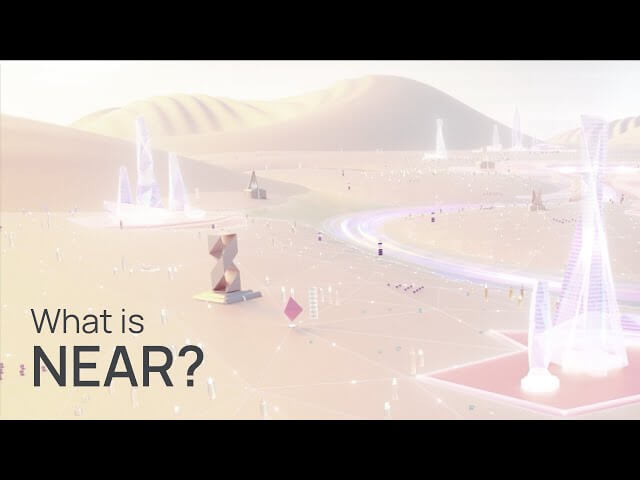NEAR Protocol (NEAR)
Aiming to Build the Infrastructure for a New InternetThe NEAR Protocol offers a fast, secure, and scalable solution for the future of Web3, and at its heart is the NEAR token. In this guide, we’ll tell you everything you need to know about NEAR, including DoomSlug and Nightshade. Curious? Grab a coffee, sit back, and read on.

What is NEAR Protocol (NEAR)?
NEAR Protocol is an infinitely scalable layer 1 blockchain. It was created by former Microsoft developer Alex Skidanov and former Google engineering manager Illia Polosukhin. To get their idea off the ground, they joined the Y Combinator venture capital program and managed to raise an impressive $50M within the first four months. The first phase of NEAR, Genesis, was launched on 22 April, 2020, with the network going full live on 13 October the same year.
The basic concept behind the NEAR Protocol is to help build the infrastructure for a ‘new internet’, which is more censorship resistant and gives users more privacy. It also aims to make blockchain technology more accessible – for example, by providing users with free human readable addresses (e.g. CryptoSpinners.near).
Like other Web3 projects, the NEAR Protocol is decentralised and will eventually be governed by a DAO (decentralised autonomous organisation). NEAR coin holders are entitled to vote on governance matters, with the number of votes determined by how many tokens are held.
| Did you know? The NEAR Protocol DAO is split into ‘Guilds’, which act like departments in a traditional company. Each one has its own specific specialisation, like marketing, human resources, and accounting. |
NEAR Protocol (NEAR) Basics
NEAR Blockchain
The NEAR blockchain uses a Delegated Proof of Stake (DPoS) consensus protocol called DoomSlug. Seriously. Interestingly, instead of employing side chains to enable scaling like many other projects, NEAR uses a sharding approach called Nightshade. This enables the network to process around 100,000 transactions per second, compared to Ethereum’s 15 per second.
If you’re wondering what sharding is, put very simply, it’s the process of splitting up a blockchain to increase capacity – kind of like adding extra lanes to a highway. Instead of each node in the network having to handle the entire blockchain, each transaction will be randomly assigned to just a portion of the available nodes.
NEAR Staking
DPoS means that even those without the resources, or inclination, to run their own nodes can still take part in staking by delegating their tokens to a chosen validator.
NEAR Supply and Tokenomics
1 billion NEAR tokens were created at Genesis, and a further 5% of additional supply will be issued per year to support the network. 90% of the new supply will go to validators, and 10% to the protocol treasury. 30% of transaction fees are rebated to contracts touched by a transaction, and the remaining 70% is burned.
NEAR Adoption & Usability
The NEAR token is primarily used to power the NEAR ecosystem through staking and rewards, but it can also be traded in its own right on the secondary market. At the time of writing in November 2022, NEAR was the 35th biggest crypto by market capitalization (according to CoinGecko).
In addition to a vibrant native ecosystem, there’s also a layer 2 scaling solution for NEAR called Aurora. It is based on the EVM (Ethereum Virtual Machine), and allows developers to easily add their Ethereum apps, thus making them available to the NEAR ecosystem.
NEAR Protocol Fees & Speed
NEAR’s DoomSlug protocol enables the achievement of practical finality on the blockchain after just a single round of communication. By comparison, Ethereum waits for 35 blocks before achieving practical finality. Hence, transactions on NEAR are completed extremely quickly. The average transaction cost on NEAR protocol is very low, at around $0.01.
NEAR Security and Safety
As previously mentioned, NEAR uses a delegated proof-of-stake consensus mechanism to secure the network. It also employs sharding, which in addition to facilitating scaling, has the added benefit of increasing security, because any hacker would have to take control of a huge part of the network for quite a while to have any success.
Security and safety tips:
- Don’t leave your NEAR on-exchange for longer than absolutely necessary. If you are not currently trading, transfer them to a local wallet for short-term storage or staking.
- For long-term storage or staking, keep your crypto in a hardware wallet.
- Always keep your wallet keys in multiple safe places – they cannot be recovered.
- Never tell anyone about your crypto holdings. No matter how secure your storage is, if you or your loved ones are physically threatened, you’ll probably hand over your personal keys.
NEAR Volatility
Unsurprisingly for a crypto launched in 2020, NEAR has endured significant volatility, going from an all-time low of $0.53 on 4 November 2020, to a high of $20.44 on 16 Jan 2022. At the time of writing in late November 2022, it had collapsed back to just over $1.60.
Final Word on NEAR Protocol (NEAR)
The NEAR Protocol has very lofty ambitions and is competing with a host of other Web3 projects, like Avalanche and Solana for example. Technically, it is impressive, with sharding already in use (by comparison, Ethereum plans to implement it, but it might be a long wait), and a layer 2 solution available to allow compatibility with Ethereum apps.
Of course, the price potential of the NEAR token itself is entirely dependent on the success of the wider protocol. For example, if the network transactions reach a certain point, the burning policy may lead to the token becoming deflationary, which will make it more attractive to investors on secondary markets too.
But, ultimately, the NEAR protocol will need to find mainstream adoption to be sustainable in the long-term. And, like always, this will require resources, excellent marketing, and a lot of luck.

